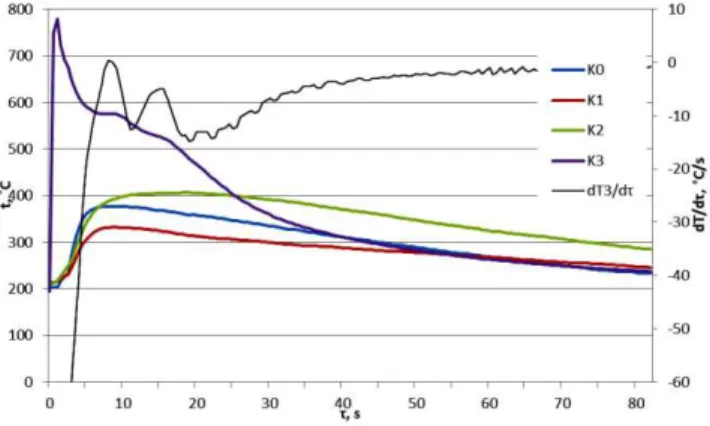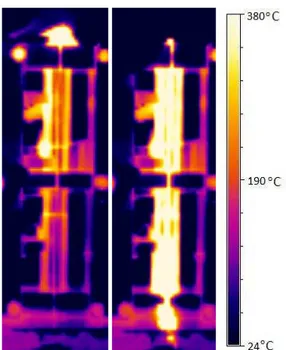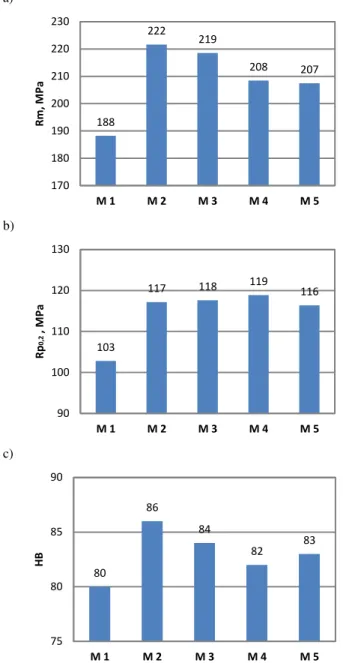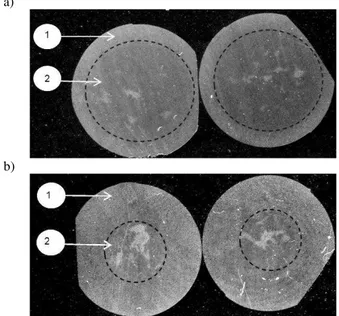A R C H I V E S
o f
F O U N D R Y E N G I N E E R I N G
Published quarterly as the organ of the Foundry Commission of the Polish Academy of Sciences
ISSN (1897-3310) Volume 12 Issue 4/2012
145 – 150
25/4
Effect of Multipoint Sequential Water Mist
Cooling of Casting Die on Microstructure
and Mechanical Properties of AlSi11 Alloy
R.
Władysiak
Department of Materials Engineering and Production Systems, Technical University of Lodz, 1/15 Stefanowskiego Street 90-924 Lodz, Poland
Corresponding author. E-mail address: ryszard.wladysiak@p.lodz.pl
Received 16.07.2012; accepted in revised form 03.09.2012
Abstract
The work is a continuation of research on the use of water mist cooling in order to increase efficiency of the die-casting process for aluminum alloys. The paper describes the multipoint sequential cooling system of the casting die and its computer control and monitoring. It also includes results of the tests and analysis of cooling methods during making of the casting. These methods differ from each other in the sequence of casting die cooling and cause effective changes in microstructure and mechanical properties of castings made of AlSi11 alloy. The study demonstrated that the use of multipoint sequential cooling with water mist affects the microstructure refinement and reduces the segregation in the cast as well as more than by 20% increases the mechanical properties of castings in the rough state. The study also demonstrates that the sequential cooling of casting die accelerates the cooling of the casting and shortens die-casting cycle.
Keywords: Innovative Foundry Technologies and Materials, Casting Die Cooling, Water Mist, AlSi11, Microstructure, Mechanical
Properties
1. Introduction
This work is a part of the studies on the application of water mist system for multiple sequential cooling chill to produce castings from aluminum alloys [1-8]. Currently, the industry uses two methods of cooling of permanent molds – the first consisting of the heat received by compressed air, which is very energy intensive due to the low efficiency of heat transfer through the air and the second one based on cooling with the water. The key subject of the research is the efficient cooling with the use of water mist through evaporation of water droplets on a hot surface of the casing die.
The aim of this study was to investigate the effect of sequential multipoint cooling with the water mist on the mechanical
properties of Rm, R p0,2, A5 and HB of casts made of AlSi11
alloy.
2. Experimental
Studies were conducted on the research station, which scheme is shown in Figure 1 using the casting die presented in Figure 2. Water mist produced in the unit (1, 2) by dosing 0.08 l/min of water and 150 l/min compressed air. Water droplets are produced through the use of swirl jet (3) in the line of compressed air (9), which was moving them to cooled chill zone (10).
the casting and the chill with an accuracy of 0.1C and a frequency of 1/s. For the analysis of temperature changes in the heat transfer zones (Fig. 2) Optris PI infrared camera was used.
Research metal chill (Fig. 2) was made of X38CrMoV5-1 steel. In the body of the chill were installed symmetrically 3 sections of cooling nozzles. The nozzles were placed in such a way that each section of the nozzles cooled each zone of the chill and the casting. Cooling jets was controlled by the computer control system (Fig. 1, pos. 6) developed by Z-Tech Company. The system software includes a set of functions and procedures to monitor and control the course of the water mist generation in the multi-circuit cooling system using a pre-drafted program. In this metal casting die (Fig. 2) the "Rm" samples were cast from technical unmodified silumin AlSi11, using cooling methods M1-M5 presented in Table 1.
Table 1.
Chill cooling methods In
order
M 1 M 2 M 3 M 4 M 5
Zone of research chill
1
With-out cooling
1 0 2 0, 1 i 2
The same time
2 0 i 2 1 i 2 0 i 1
3 0, 1 i 2 0, 1 i 2 0, 1 i 2
To assess the cooling influence on the microstructure there was used a microscope "Nikon MA200" and a computer image analysis system NIS Elements. The effect of sequential cooling on the mechanical properties of silumin castings was performed with use of static tensile testing machine INSTRON 4485 and hardness testing machine Briviskop.
Fig. 1. The scheme of the research station: Modules: 1, 2 – air and water dosing, 3 – mixing of components, 4, 5 – supplying of air
and water solenoid valves, 6 – computer cooling control, 7, 8 – PC, 9 – cooling circuit, 10 – research chill
Fig. 21. Cross section of the chill and the cast, zoning designation of nozzles
3. Results
3.1. Control program development
The preliminary study shows that in order to obtain the quality of measuring part of the sample cast there should be given the priority to the casting crystallization zone 1, followed by cooling of the rest of the casting and chill. In order to determine the crystallization temperature of the casting and chill temperatures corresponding thermal and derivational analysis was performed. Its exemplary results are shown in Figure 3 and 4 and also in the Table 2.
Fig. 3. Self-cooling of the casting (K3, DT3 / dt) and chill zones (K0, K1, K2) pre-heated to 200°C, uncooled
Table 2.
The temperature of the casting and the chill in the process of crystallization
Zone 0 Zone 1 Zone 2 Casting
Temperature, C
Cryst. start 376 331 394 576
Fig. 4.Chill temperature changing during the pouring stage
The temperature values was used as the basis for developing, the algorithm logic of control program as shown in Figure 4.
Pouring of die
Cooling off K1>330 C
K1<330 C t>7
K1<150 C t>7
K1<100 C t>7
K3<60 C Cooling
of zone 1
Cooling of all zones
Pulsation of water
60%
Pulsation of water
40%
Y Y Y Y Y
N N
N
N
N
Fig. 5. Algorithm logic of control program
The control program starts the cooling process in the 1. zone as soon as possible after filling the mold with the liquid metal, and at the latest at the beginning of crystallization of silumin, i.e. 330 C. Then, after the silumin crystallization is finished, the program begins with the cooling of the other zones, which will no longer supply the zone 1 with the liquid metal,, but instead accelerate the process of cooling of the entire cast. The program ends cooling of the chill after reaching the temperature of 60 C for casting. The program also contains a condition of water pulsation after temperature reduction by mold below 150 C and then 100 C. This condition reduces the amount of water in a mist along with the decreasing ability of the evaporation on the cooled wall of the pre-chill and thereby reduces the possibility of water gathering at the casting station.. Moreover, research shows that reducing the amount of water at this stage did not affect the cooling rate and the total time of casting. The cooling process ends when they
reach the permanent molds temperature below 60 ° C.
Table 3 shows the record of the control program put into the control system cooling chill and Figure 5 shows the registration process of the valve control system of water mist cooling of the chill.
Table 3.
Conditional record of control program
Condition Action
(K1>330) Z3=10; Z4=10; Z11=10; Z12=10
(K1<320) *(TIME>7)
Z1=10; Z2=10; Z3=10; Z4=10; Z5=10; Z6=10; Z9=10;Z10=10; Z11=10; Z12=10; Z13=10; Z14=10 (K1<150)
*(TIME>7)
Z1=6;Z2=6;Z3=6;Z4=6;Z5=6;Z6=6; Z9=10;Z10=10;Z11=10;Z12=10;Z13=10;Z14=10 (K1<100)
*(TIME>7)
Z1=4;Z2=4;Z3=4;Z4=4;Z5=4;Z6=4; Z9=10;Z10=10;Z11=10;Z12=10;Z13=10;Z14=10
(K3<60) Z1=0;Z2=0;Z3=0;Z4=0;Z5=0;Z6=0;
Z9=0;Z10=0;Z11=0;Z12=0;Z13=0;Z14=0
Fig. 6. The course of valves (Z1-Z6 of water and Z9-Z14 of air) of water mist cooling system during the casting process; Z5, Z6, Z13, Z14-chill zone 0, Z3, Z4, Z11, Z12-chill zone 1, Z1, Z2, Z9, Z10 - Zone 2 chill, casting stages: I – pouring the chill, II - the cooling of liquid metal, III - crystallization of the
For the resulting program there were developed variants of the corresponding methods of cooling chill in the Table 1.The study of sequential cooling effect of water mist for the cooling time of the casting in temperature ranging from start of the crystallization to temperature of 200 C shows that the applied cooling decreased about 10-fold casting cooling time compared to non-cooled chill, in which case self-cooling time was around 200s. The difference of casting cooling time for methods 2 to 5 varies between 2 to 4 s. The shortest casting time was obtained using the method 5, which was the simultaneous cooling of all the chill zones.
3.2. Mechanical properties
Figure 7 shows the properties of Rm, Rp0.2, HB obtained with
the use of tested water mist cooling sequence (Table 1).
Research shows that castings obtained from the uncooled chill are characterized by the smallest properties, but still meet the requirements of technical standard for AlSi11 silumin cast with the gravity die casting. Furthermore, an application of water mist cooling the chill in the tested methods of production (M2 - M5) of casts far exceeds the value of Rm, R p0.2, and HB minimum
required technical standard for silumin AlSi11, meeting the much higher requirements for pressure die casting.
A comparison of production methods shows that the greatest properties values were obtained by the castings manufactured according to method 2. The achieved tensile strength Rm is approximately 222 MPa, at a maximum value of 231 MPa. This means an approximately 20% increase in tensile strength compared to casting without cooling water mist (method 1). Similarly high values reach another property castings produced with cooling method 2 yield strength Rp0.2 = 119 MPa - an
increase of about 15%, and hardness, which reaches a value of 86 HB. Silumin elongation increased from A5 = 2.0% for uncooled
castings to A5 = 2.6% chilled casting with method 2. The analysis of hardness testing shows that water mist cooling increases the hardness of castings to the value in the range 82 86 HB. This hardness is about 70% higher compared to the required technical standard (HB 55) for die-casting and therefore meets the requirements of hardness of pressure die casting.
a)
188
222
219
208 207
170 180 190 200 210 220 230
M 1 M 2 M 3 M 4 M 5
R
m
,
M
P
a
b)
103
117 118 119
116
90 100 110 120 130
M 1 M 2 M 3 M 4 M 5
Rp
0,2
,
M
P
a
c)
80
86
84
82
83
75 80 85 90
M 1 M 2 M 3 M 4 M 5
HB
Fig. 7. Effect of cooling method (Table 1) on the tensile strength Rm (a), R p0.2 (b) and hardness HB (c) of silumin AlSi11
3.3. Microstructure and quality of casting
are smaller and they are many more, and also their porosity was smaller than in the casting uncooled.
In the microstructure of obtained castings a segregation was observed, which causes variety of cross-sectional cast microstructure between two areas: boundary layer and the core (Fig 9). The study shows that the use of sequential test chill cooling during crystallization and cooling causes about the 3-fold increase in the thickness of the boundary layer region, while reducing the core of about 7 to 4 mm. The segregation of the core cast was observed in a concentrated form, while for uncooled casting the segregation was dispersed. The boundary layer consists of many more pre-eutectic crystallized α phase dendrites than the core.
The observation of the casting’s microstructure obtained with the method 2 shows that the eutectic precipitates β phase is more refined in the boundary layer (Fig. 8 c) than in the core (Fig. 8 d), despite the presence of the few 7 to 8 microns big β phase plates. In addition, studies show that on the boundary of both layers there are clusters of very fine eutectic α+β (transient layer). They are formed most likely by the mixture of liquid metal and the β-phase crystal nuclei from neighboring zones. The computer image analysis of the β phase precipitates shows that the average size of eutectic precipitates in the transition layer of the core is 2.36 microns, while for the boundary layer their size is larger and amounts to 2.83 microns. Furthermore, one can find large α phase dendrites in the microstructure of these areas.
To sum up the work, it should be noted that the use of multi-point sequential cooling of metal mold with reduced wall thickness allows a good quality castings with low shrinkage porosity. The castings that have been made without cooling had high porosity within the casting and collapsed walls in the places where the cross-sections of the casting transitioned. In the raw casting cooled with the water mist a clearly visible shrink hole was produced on the surface of the pouring gate, which confirms the effectiveness of supplying the cast through this riser.
Accounted for less than 10% of the raw casting’s volume and thus was defining a very high - at least 90% yield of the metal. Less significant advantages of castings obtained with use of the cooling water mist also include the reduction of surface roughness of the castings, i.e. they are characterized by smooth and glossy surface.
a)
b)
c)
d)
Fig. 8. Microstructure of casting obtained: a) without cooling, b), c), d) with water mist cooling system method 2; α dendrites, α+β
a)
b)
Fig. 9. Segregation of casting obtained: a) without cooling, b) with water mist cooling system method 2; 1- boundary layer, 2
– core of cast.
4. Conclusions
The work shows that the use of the multipoint sequential water mist cooling systems at the die casting:
- allows computer control of the casting process using a dedicated software for regulating the chill cooling rate and consequently the crystallization front and the quality of casting,
- allows reduction of the casting total time from 200 s to 20 s and increase efficiency of casts manufacturing,
- increases 3-times the boundary layer thickness decreasing therefore the segregation in the cast’s microstructure, - reduces the porosity and extends the refinement of silumin
AlSi11 microstructure, in which the eutectic β phase precipitates are characterized by a compact composition with an average size ranging from 2 3 microns,
- increases by over 20% the mechanical properties of silumin AlSi11, which amount to: Rm = 222 MPa,
R p0, 2 = 119 MPa, A5 = 2.6% and HB = 86,
Acknowledgements
The work was made as a part of the research project No. N N508 399237 financed by funds for science in the years 2009-2012 by the Polish Ministry of Science and Higher Education
References
[1] Władysiak R. (2007). Effective Intensification Method of Die Casting Process of Silumins. Archives of Metallurgy.
52(3), 529-534.
[2] Władysiak R. (2007). Assessment of Effectiveness of Water
Mist Cooling of Casting Die. Archives of Foundry
Engineering, 7(4), 175-182.
[3] Władysiak R. (2008). Water mist effect on heat transfer coefficient in cooling of casting die. Archives of Foundry Engineering, 8(3), 227-236.
[4] Władysiak R.( 2008). Water mist effect on cooling range and efficiency of casting die. Archives of Foundry Engineering, 8(4), 213-218.
[5] Władysiak R. (2010). Effect of water mist on cooling process of casting die and microstructure of AlSi11 alloy. Archives of Metallurgy and Materials, 55(3), 939-946.
[6] Władysiak R. (2010). Water mist effect on cooling process of casting die and microstructure of AlSi9 alloy. Archives of Foundry Engineering, 10(2), 185-194
[7] Władysiak R. (2011): Heat transfer analysis during cooling of die with use of water mist. Archives of Foundry Engineering, 11(2), 167-174.




